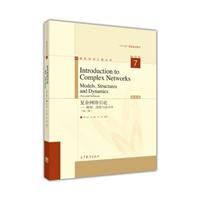
Introduction to Complex Networks:Models, Structures and Dynamics(2nd)
[Book Description]
The book is divided into two parts: Part I fundamental Theory present backgound information and basic materials needed to learn the subject. Part II Applications Selected Topics copntains several selected application-oriented topics.
[Table of Contents]
part i fundamental theory
chapter 1 introduction
1.1 background and motivation
1.2 a brief history of complex network research
1.2.1 the ksnigsburg seven-bridge problem
1.2.2 random graph theqry.
1.2.3 small-world experiment
1.2.4 strength of weak ties
1.2.5 new era of complex-network studies
1.3 some basic concepts
1.3.1 graph representation of networks
1.3.2 average path length
1.3.3 clustering coefficient
1.3.4 degree and degree distribution
1.3.5 statistical properties of some real-world complex networks
problems
references
chapter 2 a brief introduction to graph theory
2.1 what is a graph?
2.2 notation, definitions and preliminaries
2.3 eulerian and hamiltonian graphs
2.3.1 eulerian graphs
2.3.2 hamiltonian graphs
2.4 the chinese postman problem
2.5 the shortest path length problem
2.6 trees
2.7 the minimum connector problem
2.8 plane graphs and planar graphs
2.9 euler formula for plane graphs
2.10 directed graphs
problems
references
chapter 3 network topologies: basic models and properties
3.1 introduction
3.2 regular networks
3.3 random-graph networks
3.4 small-world network models
3.4.1 the ws small-world network model
3.4.2 the nw small-world network model
3.4.3 statistical properties of small-world network models
3.5 the navigable small-world network model
3.6 scale-free network models
3.6.1 the ba scale-free network model
3.6.2 robustness versus fragility
3.6.3 modified ba models
3.6.4 a simple model with power-law degree distribution
3.6.5 local-world and multi-local-world network models
problems
references
part ii applications: selected topics
chapter 4 internet: topology and modeling
4.1 introduction
4.2 topological properties of the internet
4.2.1 power-law node-degree distributions
4.2.2 hierarchical structures
4.2.3 rich-club structure
4.2.4 disassortative property
4.2.5 coreness and betweenness
4.2.6 growth of the internet
4.2.7 router-level internet topology
4.2.8 geographic layout of the internet
4.3 random-graph network topology generator
4.4 structural network topology generators
4.4.1 tiers topology generator
4.4.2 transit-stub topology generator
4.5 connectivity-based network topology generators
4.5.1 inet
4.5.2 brite model
4.5.3 glp model
4.5.4 pfp model
4.5.5 tang model
4.6 multi-local world model
4.6.1 theoretical considerations
4.6.2 numerical results with comparison
4.6.3 performance comparison
4.7 hot model
4.8 dynamical behaviors of the internet topological characterics
references
chapter 5 spreading dynamics
5.1 introduction
5.2 epidemic threshold theory
5.2.1 epidemic models
5.2.2 epidemic thresholds on homogenous networks
5.2.3 statistical data analysis
5.2.4 epidemic thresholds on scale-free networks
5.2.5 epidemic thresholds on ba scale-free networks
5.2.6 epidemic thresholds on finite-sized scale-free networks
5.2.7 epidemic thresholds on correlated networks
5.2.8 epidemic thresholds on some generalized scale-free networks
5.2.9 sir model of epidemic spreading
5.3 immunization on complex networks
5.3.1 random immunization
5.3.2 targeted immunization
5.3.3 acquaintance immunization
5.4 comiputer virus spreading over the internet
5.4.1 random constant spread model of the code-red w
5.4.2 a compartment-based model of computer worms
5.4.3 spreading models of e-mail viruses
5.4.4 effects of computer virus on network topologies
5.5 other spreading phenomena on complex networks
5.5.1 rumors spreading over social networks
5.5.2 some generalized models of spreading dynamics
references
chapter 6 cascading reactions on networks
6.1 introduction
6.2 dynamic cascading failures: models and analyses
6.2.1 models based on node dynamics
6.2.2 models based on edge dynamics
6.2.3 hybrid models based on node and edge dynamics
6.2.4 binary influence model
6.2.5 sand-pile model
6.2.6 opa model
6.2.7 casade model
6.2.8 other models
6.3 cascading failures in coupled map lattices
6.3.1 cascading failure model based on cmls
6.3.2 cascading failures on typical coupling lattices
6.4 cascading failures of interdependent networks
references
chapter ? human opinion dynamics
7.1 introduction
7.2 social network topologies and sociodynamics
7.3 social opinion formation
7.3.1 voter model
7.3.2 galam majority-rule model
7.3.3 latane social impact theory
7.3.4 sznajd model
7.3.5 virtual social game on the internet
7.3.6 online social opinion formation
7.4 bounded confidence models
references
chapter 8 network synchronization
8.1 introduction
8.2 complete synchronization of continuous-time networks
8.2.1 complete synchronization of general continuous-time networks
8.2.2 complete synchronization of linearly coupled continuous-time
networks
8.3 complete synchronization of some typical dynamical networks
8.3.1 complete synchronization of regular networks
8.3.2 synchronization of small-world networks
8.3.3 synchronization of scale-free networks
8.3.4 complete synchronization of local-world networks
8.4 phase synchronization
8.4.1 phase synchronization of the kuramoto model
8.4.2 phase synchronization of small-world networks
8.4.3 phase synchronization of scale-free networks
8.4.4 phase synchronization of non-uniformly coupled networks
references
chapter 9 network control
9.1 introduction
9.2 spatiotemporal chaos control on regular cml
9.3 pinning control of complex networks
9.3.1 augmented network approach
9.3.2 pinning control of scale-free networks
9.4 pinning control of general complex networks
9.4.1 stability analysis of general networks under pinning control
9.4.2 pinning and virtual control of general networks
9.4.3 pinning and virtual control of scale-free networks
9.5 time-delay pinning control of complex networks
9.6 consensus and flocking control
references
chapter 10 brief introduction to other topics
10.1 network modularity and community structures
10.2 human mobility and behavioral dynamics
10.3 web pagerank, siterank and browserrank
10.4 recommendation systems
10.5 network edge prediction
10.6 living organisms and bio-networks
references
index

 新书报道
新书报道